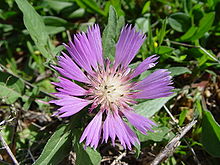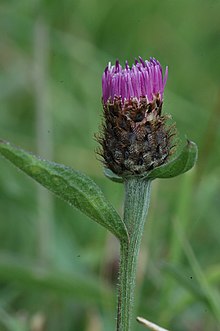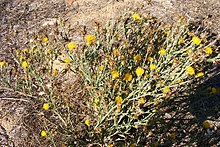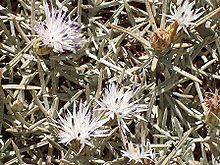Centaurea
| Centaurea | |
|---|---|

| |
| Centaurea pullata | |
| Scientific classification | |
| Kingdom: | Plantae |
| Clade: | Tracheophytes |
| Clade: | Angiosperms |
| Clade: | Eudicots |
| Clade: | Asterids |
| Order: | Asterales |
| Family: | Asteraceae |
| Subfamily: | Carduoideae |
| Tribe: | Cardueae |
| Subtribe: | Centaureinae |
| Genus: | Centaurea L. |
| Type species | |
| Centaurea paniculata L.
| |
| Diversity | |
| Over 700 species | |
| Synonyms | |
|
List
| |
Centaurea(/ˌsɛntɔːˈriːə/)[1]is agenusof over 700 species ofherbaceousthistle-like flowering plants in the familyAsteraceae.Members of the genus are found only north of the equator, mostly in the Eastern Hemisphere; the Middle East and surrounding regions are particularly species-rich.
Common names
[edit]Common names for this genus arecentaury,centory,starthistles,knapweeds,centaureasand the more ambiguous "bluets";a vernacular name used for these plants in parts of England is"loggerheads"(common knapweed). ThePlectocephalusgroup – possibly a distinct genus – is known asbasketflowers."Cornflower"is used for a few species, but that term more often specifically means eitherC. cyanus(the annual cornflower) orCentaurea montana(the perennial cornflower). The common name "centaury"is sometimes used, although this also refers to the unrelated plant genusCentaurium.[2]
The name is said to be in reference toChiron,the centaur ofGreek mythologywho discovered medicinal uses of a plant eventually called "centaury".[3]
Description
[edit]Knapweeds are robustweedyplants. Their leaves, spiny in some species, are usually deeply divided into elongated lobes at least in the plants' lower part, becoming entire towards the top. The "flowers" (actuallypseudanthiuminflorescences) are diverse in colour, ranging from intense blues, reds and yellows to any mixture of these and lighter shades towards white. Often, thedisk flowersare much darker or lighter than theray flowers,which also differ inmorphologyand aresterile.Each pseudanthium sits atop a cup- or basket-like cluster of scalybracts,hence the name "basketflowers". Many species, in particular those inhabiting morearidregions, have a long and strongtaproot.



Ecology
[edit]Certain knapweeds have a tendency to dominate large stretches of landscape together with a few other plants, typically one or two grasses and as many other large herbaceous plants. Thecommon knapweed(C. nigra) for example is plentiful in themesotrophic grasslandsof England and nearby regions. It is most prominently found in pastures or meadows dominated bycock's-foot(Dactylis glomerata) as well as either ofcrested dog's-tail(Cynosurus cristatus) andfalse oat-grass(Arrhenatherum elatius). It is also often found in mesotrophic grassland onrendzinasand similarcalcareous soilsin association withglaucous sedge(Carex flacca),sheep's fescue(Festuca ovina), and eithertor-grass(Brachypodium pinnatum) andrough hawkbit(Leontodon hispidus), orupright brome(Bromus erectus). In thesegrasslands,greater knapweed(C. scabiosa) is found much more rarely by comparison, often in association withred fescue(Festuca rubra) in addition to cock's-foot and false oat-grass.
Due to their habit of dominating ecosystems under good conditions, manyCentaureaspecies can becomeinvasive weedsin regions where they are not native. In parts of North America,diffuse knapweed(C. diffusa),spotted knapweed(C. maculosa) andyellow starthistle(C. solstitialis) cause severe problems inagriculturedue to their uncontrolled spread. Theseedsare typically transported by human traffic, in particular thetiresofall-terrain vehicles.The two knapweeds are harmful mainly because they are stronglyallelopathic,producing powerfultoxinsin theirrootsthat stunt the growth of plants around them not adapted to this.[4]Yellow starthistle, meanwhile, is inedible to mostlivestockdue to its spines and apparently outrightpoisonoustohorsesand otherequines.However, efficient methods ofbiological controlby insectpestsof these weeds have been developed; the knapweeds can also exploited to their detriment bytargeted grazing.Controlled burningmay also be used, though the timing is important to avoid the plants having seeded already, and neither allowing sufficient time for them to regrow from the rootstock.[5]
Yet other species ofCentaurea– mostly ones that occur between Italy and theCaucasus– areendemicsof a single island or valley, and some of these areendangered.TheAkamas Centaurea(Centaurea akamantis) ofCyprusis almostextinct,while the western Caucasus endemicsC. leptophyllaandC. straminicephalaare at least very rare andC. hedgeiandC. pechofrom the same region are certainly not abundant either. The last four species would be adversely affected by the proposedYusufeli Dam,which might actually destroy enoughhabitatto push the two rarer ones over the brink of extinction.

This butterfly can spend their entire lives living off a patch ofbrown knapweed(C. jacea).
Centaureaare copiousnectarproducers, especially on high-limesoils.The high nectar yield of the genus makes it very attractive toinsectssuch asbutterflies– including theendangeredKarner blue(Plebejus melissa samuelis) which visits introduced spotted knapweed – and day-flyingmoths– typicallyZygaenidae,such asZygaena lotior thesix-spot burnet(Z. filipendulae). Thelarvaeof some otherLepidopteraspecies useCentaureaspecies as food plants; see List of Lepidoptera that feed onCentaurea.Several of these are used in biological control of invasive knapweeds and starthistles.
Larvaeof severaltrue weevils(Curculionidae) of thesubfamilyLixinaealso feed onCentaurea.Somegenera– such asLarinuswhose larval food is flowerheads – have many species especiallyadaptedto particular knapweeds or starthistle and are used in biological control too. These include theyellow starthistle flower weevil(L. curtus) for yellow starthistle,lesser knapweed flower weevil(L. minutus) for diffuse knapweed andblunt knapweed flower weevil(L. obtusus) for spotted knapweed.Broad-nosed seedhead weevil(Bangasternus fausti) larvae eat diffuse, spotted andsquarrose knapweed(C. virgatassp.squarrosa), while those of theyellow starthistle bud weevil(B. orientalis) do not seem to live on anything other than yellow starthistle and occasionallypurple starthistle(C. calcitrapa). But perhaps most efficient in destroying developing yellow starthistle seedheads is the larva of theyellow starthistle hairy weevil(Eustenopus villosus).Knapweed root weevil(Cyphocleonus achates) larvae bore into the roots of spotted and to a lesser extentely diffuse knapweed, sometimes killing off the entire plant.
Also used in biological control areTephritidae(peacock flies) whose larvae feed onCentaurea.Knapweed peacock fly(Chaetorellia acrolophi) larvae eat spotted knapweed and some other species. Theyellow starthistle peacock fly(C. australis) has an initialgenerationeach year which often usescornflower(C. cyanus) as larval food; later generations switch to yellow starthistle. The flies are generally considered less efficient in destroying the growing seedheads than the weevils, but may be superior under certain conditions; employing flies and weevils in combination is expensive and does not noticeably increase their effect.
Use by humans
[edit]Despite the negative agricultural and environmental impacts of the more aggressive Centaurea species, there are many ways in which they benefit humans as well. For instance, due to their moderate to high nectar production, which can occur over a comparatively long duration, many species ofCentaureaare popular food sources forinsectsthat may otherwise attack certaincrops.[citation needed]It may be advisable for some types of farms to allow certain Centaurea species, such ascornflower(C. cyanus) in a European setting, to grow adjacent to fields. These areas are known asbeetle banks,though they support and attract a diversity of beneficial life beyond beetles. When certain Centaurea species are present, some pests may be drawn away from crops, and predatory insects andarachnidsthat feed upon pest insects will be better-supported by these more naturalized areas. They additionally have the beneficial aspect of supportingpollinators,unlike many field crops such asmaize.Moreover, being untreated withpesticidesand providing morediversity,plants growing in more wild areas adjacent to farms produce more insects that attract and support birds which can also feed on pests that would harm crops. Insect production is especially high for beetle banks that have enough plants that serve in the role of host plant for immature insects, rather than just in the roles of adult food and/or shelter provision.
Some plants which are considered invasive or problematic in certain areas can have beneficial qualities that outweigh their negative qualities from a human and/or human agricultural point of view, although this sometimes requires some human management – particularly if adequate biological control has not been established for the more aggressive species. An example is wild parsnip,Pastinaca sativa,which produces florets that feed predatory (and other beneficial) insects as well as large tubular stems that provide winter shelter for native bees, wasps, and other organisms that can be beneficial for agriculture. The plant is considered invasive in some areas of the United States and is also often considered undesirable due to its ability to cause contact skin irritation. However, it also serves as a host plant for the black swallowtail butterfly, helps to bring nutrients up from soils with its deep taproot, and possesses evergreen foliage even in climate zones such as US zone 6. This foliage increases soil warmth and moisture which can be beneficial for certain types of life. Perhaps the most dramatic example of a generally disliked plant's beneficial qualities being usually overlooked is the often-despised ragwort,Jacobaea vulgaris,which topped the list by a large amount for nectar production in a UK study, with a production per floral unit of (2921 ± 448μg).[6]This very high nectar production, coupled with its early blooming period, makes the plant helpful for the establishment of bee colonies in spring — a period that is often not well-served by commercial flower meadow seed mixes.[7]It also has the situationally-beneficial quality of being a springephemeral,as well as an annual that lacks difficult-to-combat roots. Plants that provide necessary structural supports forinvertebrateand smallvertebratepredatorscan help to keep overall pest populations low.[8]

The abundantnectarproduced byC. solstitialisflowers attracts manypollinators.This is another reason for the success of the (situationally) highlyinvasive species.Due to genetic differences related to evolutionary adaption, not all members ofCentaureaproduce the same amount of nectar. Growing conditions, such as climate and soil, can have a very strong impact, even if the plants grow and flower. For instance, cornflower plants,Centaurea cyanus,produced 33% less seasonal nectar thanCentaurea nigrain a UK study.[6]C. nigraalso ranked higher than ragwort in another UK study, although ragwort was still in the top 10 for yearly nectar production.[7]The strong nectar production of certain members of the genus can be exploited to the farmer's advantage, possibly in combination withbiological control.In particular, theyellow starthistle(C. solstitialis) as well asspotted knapweed(C. maculosa) are majorhoneyplants forbeekeepers.Monofloral honeyfrom these plants is light and slightly tangy, and one of the finest honeys produced in the United States – due to its better availability, it is even fraudulently relabeled and sold as the scarce and expensivesourwoodhoney of theAppalachian Mountains.Placingbeehivesnear stands ofCentaureawill cause increased pollination. As most seedheads fail however when biocontrol pests have established themselves, the plants will bloom ever more abundantly in an attempt to replace the destroyed seedheads, to the point where they exhaust their resources in providing food for the pests (seeds), bees (pollen) and humans (honey). Output ofallelopathiccompounds is also liable to be reduced under such conditions – the plant has to compromise between allocating energy to reproduction and defense. This renders the weeds more likely to be suppressed by native vegetation or crops in the following years, especially if properly timedcontrolled burning[5]and/ortargeted grazingby suitablelivestockare also employed. While yellow starthistle and perhaps other species aretoxictoequines,some other livestock may eat the non-spiny knapweeds with relish. In Europe,common knapweed(C. nigra) andglobe knapweed(C. macrocephala) are locally important pollen sources for honeybees in mid-late summer.
8-Hydroxyquinolinehas been identified as a main allelopathic compound produced bydiffuse knapweed(C. diffusa); native North American plants are typically sensitive to it, while those ofEastern EuropeandAsia Minorusually havecoevolvedwith the knapweed and are little harmed if at all, aided by nativemicroorganismsthat break down or even feed on the abundantly secreted compound.[4]Thus, 8-hydroxyquinoline is potentially useful to control American plants that have become invasive weeds in the diffuse knapweed's native range.

Arctiin, found inC. imperialis,has shownanticanceractivity in laboratory studies. The roots of the long-lostC. foliosa,anendemicofHatay Province(Turkey), are used in folk medicine, and other species are presumably too. A South Italian variety[verification needed]of thepurple starthistle(C. calcitrapa) is traditionally consumed by ethnic Albanians (Arbëreshë people) in theVulture area(southern Italy); e.g. in the Arbëreshë communities inLucaniathe young whorls ofC. calcitrapaare boiled and fried in mixtures with other weedy non-cultivated greens. According to research by the Michael Heinrich group at the Centre for Pharmacognosy and Phytotherapy (School of Pharmacy, University of London) "theantioxidantactivity [...] of the youngwhorlsofCentaurea calcitrapa,both in theDPPHand in thelipid peroxidationinhibition assays, [is] very interesting and [the] species should be investigated phytochemically and biochemically focusing on these properties ". Extracts fromC. calcitrapawere furthermore found to have significantxanthine oxidase(XO)-inhibiting activity.[9]
Spotted knapweed as well as other species are rich incnicin,abittercompound found mainly in the leaves and often used to flavor thedigestifamaro.In westernCrete,Greecea localvariety[verification needed]ofC. calcitrapacalledgourounaki(γουρουνάκι"little pig" ) also has its leaves eaten boiled by the locals. In the same island an endemic local species,C. idaeacalledkatsoula(κατσούλα),tsita(τσίτα) oraspragatha(ασπραγκάθα), has its leaves eaten boiled by the locals too.[10]
Cornflowerblue
#6495ED
Some species are cultivated asornamental plantsingardens.As regards other aspects ofpopular culture,cornflower(C. cyanus) is thefloral emblemofÖstergötlandprovince (Sweden) – where is it calledblåklint,literally "blue mountain" – and ofPäijänne Tavastiaregion inFinland,where it is known asruiskaunokki( "rye-beaks ") orruiskukka( "rye-flower" ). It is also the national flower ofEstoniawhere its local namerukkilillmeans "rye-lily",Belaruswhere it is calledvałoška(Belarusian:валошка), and one of those of Germany where it is calledKornblume( "cornflower" ). The origin of the name "caltrop"for the ancient low-techarea denialweapon is probably in some way connected withC. calcitrapaand its spiny seeds. This plant is attested to by the colloquial name "caltrop" at a time when the weapons were still called by theirRomannametribulus.[11]Lastly, thecolorcornflower blueis named afterC. cyanus.Cornflower is also used as a cut flower.
Systematics and taxonomy
[edit]
As namesake member of thesubtribeCentaureinaeoftribeCardueae,the knapweeds are probably most closely related to genera such asCarthamus(distaff thistles),Cnicus(blessed thistle),Crupina(crupinas) orNotobasis(Syrian thistle), and somewhat less closely to most otherthistles.ThemonotypicCnicusseems in fact to properly belong inCentaurea.[12]
Research in the late 20th century shows thatCentaureaas traditionally defined ispolyphyletic.A number of 19th- and 20th-century efforts to reorganize the genus were not successful, and it is not yet clear what the consequences of the recent research will be for classification of this genus and other related genera. Thetype speciesC. centauriumstands somewhat apart from the main lineage of knapweeds and thus thetaxonomicconsequences of a rearrangement might be severe, with hundreds of species needing to be moved to new genera. It has thus been proposed to change the type species to one of the main lineages to avoid this problem. What seems certain however is that the basketflowers – presently treated as asectionPlectocephalus– will be reinstated as a distinct genus in the near future. Therock-centauries(Cheirolophus), formerly usually included inCentaurea,are now already treated as separate genus.[2]
-
Globe knapweed (C. macrocephala
Species
[edit]Better-knownCentaureaspecies include:
- Centaurea acaulis
- Centaurea adpressa
- Centaurea aegyptiaca
- Centaurea aeolica
- Centaurea aggregata
- Centaurea akamantis– Akamas centaurea
- Centaurea alba
- Centaurea albonitensTurrill
- Centaurea alpestris
- Centaurea alpina
- Centaurea ambigua
- Centaurea amblyolepis
- Centaurea americana– American basketflower, American starthistle
- Centaurea ammocyanus
- Centaurea antennataDufour
- Centaurea antiochiaBoiss.
- Centaurea aplolepa
- Centaurea aplolepasubsp.carueliana
- Centaurea appendicigeraC.Koch
- Centaurea argentea
- Centaurea ascalonica
- Centaurea asperaL.– rough starthistle
- Centaurea atacamensis(Reiche) I.M.Johnst.
- Centaurea atropurpurea
- Centaurea ×aurata
- Centaurea babylonicaL.
- Centaurea balsamita
- Centaurea behenL.–ak behmen(Turkish)
- Centaurea bella
- Centaurea benedicta–Cnicus
- Centaurea bieberseinii
- Centaurea borjae
- Centaurea bovina
- Centaurea bracteata
- Centaurea brevifimbriataHub.-Mor.
- Centaurea bulbosa
- Centaurea busambarensisGuss.
- Centaurea cachinalensis
- Centaurea calcitrapa– purple starthistle, red starthistle, "caltrop"
- Centaurea calcitrapoides
- Centaurea cariensisBoiss.
- Centaurea cariensiformisHub.-Mor.
- Centaurea caroli-henriciGabrieljan & Dittrich
- Centaurea centauriumL.
- Centaurea chilensis
- Centaurea cineraria– velvet centaurea, dusty miller
- Centaurea clementei
- Centaurea collinaL.
- Centaurea corymbosa
- Centaurea crithmifolia
- Centaurea crocodylium
- Centaurea cyanoidesJ.Berggr. & Wahlenb.
- Centaurea cyanus– cornflower, bachelor's button, boutonniere flower, hurtsickle, bluebottle, basketflower
- Centaurea damascena
- Centaurea debeauxiiGren. & Godr.
- Centaurea demiriziiWagenitz
- Centaurea depressa– low cornflower
- Centaurea deusta
- Centaurea diffusa– diffuse knapweed, white knapweed, tumble knapweed
- Centaurea diluta– North African knapweed
- Centaurea drabifoliaSm.
- Centaurea drabifolioidesHub.-Mor.
- Centaurea dschungarica
- Centaurea emilae Hüseynova et Qaraxani[13]
- Centaurea eriophora
- Centaurea eryngioides
- Centaurea filiformis
- Centaurea fischeriWilld.
- Centaurea floccosa
- Centaurea foliosaBoiss. & Kotschy
- Centaurea forojuliensis
- Centaurea fridericiVis.–palagruška zečina(Croatian)
- Centaurea gayana
- Centaurea gigantea
- Centaurea glaberrimaTausch
- Centaurea glastifolia
- Centaurea grinensis
- Centaurea gymnocarpa
- Centaurea haradjianiiWagenitz
- Centaurea hedgei
- Centaurea helenioidesBoiss.
- Centaurea hermanniiF.Hermann
- Centaurea horridaBadarò–fiordaliso spinoso(Italian)
- Centaurea hyalolepis
- Centaurea hypoleuca
- Centaurea iberica– Iberian starthistle, Iberian knapweed
- Centaurea idaea–katsoula,tsita(Cretan Greek)
- Centaurea imperialisHausskn. ex Bornm.
- Centaurea jabukensis
- Centaurea jacea– brown knapweed, brownray knapweed
- Centaurea kasakorum
- Centaurea kopetaghensis
- Centaurea kotschyanaHeuff.
- Centaurea lanulata
- Centaurea leptophylla
- Centaurea leucophylla
- Centaurea limbata
- Centaurea lydiaBoiss.
- Centaurea macrocephalaPuschk. ex Willd.– globe knapweed, Armenian basketflower
- Centaurea maculosa– spotted knapweed (might belong inC. stoebesubsp.micranthos)
- Centaurea mannagettae
- Centaurea margaritalbaKlok.
- Centaurea marschalliana
- Centaurea melitensis– Maltese starthistle;tocalote, tocolote(California)
- Centaurea minor
- Centaurea moschata– sweet sultan
- Centaurea ×moncktoniiC.E.Britton– meadow knapweed, protean knapweed (=C. ×pratensisThuill non Salisb.)
- Centaurea monocephala
- Centaurea montana– montane knapweed, perennial cornflower, mountain cornflower, mountain bluet
- Centaurea napifoliaL.–fiordaliso romano(Italian)
- Centaurea nervosaRchb. ex Steud.
- Centaurea nigra– common knapweed, black knapweed, lesser knapweed, hardheads
- Centaurea nigrescens– Tyrol knapweed, short-fringed knapweed, Tyrol thistle
- Centaurea nigrifimbria(C.Koch) Sosn.
- Centaurea nivea(Bornm.) Wagenitz
- Centaurea onopordifolia
- Centaurea orientalisL.
- Centaurea ornataWilld.
- Centaurea ovina
- Centaurea pallescensDelile
- Centaurea paniculataL.
- Centaurea parlatoris
- Centaurea pecho
- Centaurea phrygia– wig knapweed
- Centaurea pindicola
- Centaurea polypodiifolia
- Centaurea ×pratensisSalisb.(C. jacea × C. nigra) – meadow knapweed
- Centaurea procurrens
- Centaurea ×psammogenaG.Gayer.(C. diffusa × C. stoebesubsp.micranthos)
- Centaurea pseudocaerulescens
- Centaurea pseudophrygiaC.A.Mey.
- Centaurea pulcherrimaWilld.
- Centaurea pullataL.
- Centaurea pumilio
- Centaurea ragusinaL.
- Centaurea rigida
- Centaurea rothrockiiGreenm.– Mexican basketflower, Rothrock's basketflower, Rothrock's knapweed
- Centaurea ruthenica
- Centaurea rutifoliaSm.
- Centaurea sadleriana– Pannonian knapweed
- Centaurea salicifoliaBieb. ex Willd.
- Centaurea scabiosa– greater knapweed
- Centaurea scannensis
- Centaurea scoparia
- Centaurea scopulorumBoiss. & Heldr.
- Centaurea seguenzae
- Centaurea seridisL.
- Centaurea sibirica
- Centaurea simplicicaulis
- Centaurea sinaica
- Centaurea solstitialis– yellow starthistle, golden starthistle, yellow cockspur, St. Barnaby's thistle, Barnaby thistle
- Centaurea speciosa
- Centaurea sphaerocephalaL.
- Centaurea stenolepis
- Centaurea stoebeL.
- Centaurea stoebesubsp.micranthos(Gugler) Hayek
- Centaurea straminicephala
- Centaurea sulphurea– Sicilian starthistle
- Centaurea tauromenitanaGuss.
- Centaurea tenoreana
- Centaurea tommasinii
- Centaurea transalpinaSchleich. ex DC.
- Centaurea tchihatcheffii—yanardöner(Turkish)
- Centaurea trichocephalaBieb. ex Willd.– featherhead knapweed
- Centaurea triniifolia
- Centaurea triumfettiiAll.
- Centaurea tymphaeaHausskn.[14]
- Centaurea ucriaeLacaita
- Centaurea unifloraTurra
- Centaurea verbascifoliaVahl
- Centaurea verutumL.
- Centaurea virgata
- Centaurea virgatasubsp.squarrosa– squarrose knapweed
- Centaurea wiedemannianaFisch. & Mey.
- Centaurea yozgatensisWagenitz
Formerly placed here
[edit]Plant species placed inCentaureain former times include:
- Acroptilon repens– Russian knapweed (asC. repens)
- Cheirolophus crassifolius– Maltese rock-centaury (asC. crassifolia, C. spathulata)
- Femeniasia balearica(asC. balearica)
- Volutaria muricata(asC. muricata)
Footnotes
[edit]- ^Sunset Western Garden Book,1995:606–607
- ^abKeil (2006), Keil & Ochsmann (2006).
- ^Blackwell, Laird R. (2006).Great Basin Wildflowers: A Guide to Common Wildflowers of the High Deserts of Nevada, Utah, and Oregon (A Falcon Guide)(1st ed.). Guilford, Conn.:Morris Book Publishing, LLC.p. 57.ISBN0-7627-3805-7.OCLC61461560.
- ^abHierro & Callaway (2003), Vivancoet al.(2004).
- ^abEmery & Gross (2005).
- ^abHicks, DM; Ouvrard, P; Baldock, KCR (2016)."Food for Pollinators: Quantifying the Nectar and Pollen Resources of Urban Flower Meadows".PLOS ONE.11(6): e0158117.Bibcode:2016PLoSO..1158117H.doi:10.1371/journal.pone.0158117.PMC4920406.PMID27341588.
- ^ab"Which flowers are the best source of nectar?".Conservation Grade. 2014-10-15. Archived fromthe originalon 2019-12-14.Retrieved2017-10-18.
- ^Wäckerset al.(2005)
- ^Pieroniet al.(2002).
- ^Stavridakis (2006)
- ^In reference to their resemblance to the spiny seeds of thepuncture vine,later namedTribulus terrestris.
- ^Panero & Funk (2002), Keil (2006), Keil & Ochsmann (2006).
- ^AMEA Botanika İnstitutunun əməkdaşları Azərbaycan florasında yeni növ aşkarlayıblar.science.gov.az
- ^Centaurea tymphaeaPlants of the World Online
References
[edit]- Emery, S.M. & Gross, K.L.(2005): Effects of timing of prescribed fire on the demography of an invasive plant, spotted knapweedCentaurea maculosa.J. Appl. Ecol.42(1): 60-69.doi:10.1111/j.1365-2664.2004.00990.x(HTML abstract)
- Hierro. J.L. & Callaway, R.M.(2003): Allelopathy and exotic plant invasion.Plant and Soil256(1): 29–39.doi:10.1023/A:1026208327014PDF fulltext
- Keil, David J.(2006): 21.Plectocephalus. In:Flora of North America North of MexicoVol. 19 (Magnoliophyta: Asteridae, part 6: Asteraceae, part 1). Oxford University Press.ISBN0-19-530563-9HTML fulltext
- Keil, David J. & Ochsmann, J.(2006): 24.Centaurea. In:Flora of North America North of MexicoVol. 19 (Magnoliophyta: Asteridae, part 6: Asteraceae, part 1). Oxford University Press.ISBN0-19-530563-9HTML fulltext
- Panero, J.L. & Funk, V.A.(2002): Toward a phylogenetic subfamilial classification for the Compositae (Asteraceae).Proc. Biol. Soc. Wash.115(4): 909–922.PDF fulltextArchived2012-03-27 at theWayback Machine
- Pieroni, A.; Janiak, V.; Dürr, C.M.; Lüdeke, S.; Trachsel E. & Heinrich, M.(2002):In vitroAntioxidant Activity of Non-cultivated Vegetables of Ethnic Albanians in Southern Italy.Phytother. Res.16(5): 467–473.doi:10.1002/ptr.1243PDF fulltext
- Stavridakis, Kleonikos G.(Κ. Γ. Σταυριδάκης) (2006):Wild edible plants of Crete- Η Άγρια βρώσιμη χλωρίδα της Κρήτης [English and Greek]. Rethymnon Crete.ISBN960-631-179-1
- Vivanco, J.M.; Bais, H.P.; Stermitz, F.R.; Thelen, G.C. & Callaway, R.M.(2004): Biogeographical variation in community response to root allelochemistry: Novel weapons and exotic invasion.Ecol. Lett.7(4): 285–292.doi:10.1111/j.1461-0248.2004.00576.xPDF fulltextSupplementary material
- Wäckers, Felix; van Rijn, Paul & Bruin, Jan(2005):Plant-Provided Food for Carnivorous Insects - a protective mutualism and its applications.Cambridge University Press, UK.ISBN978-0-521-81941-1PreviewatGoogle Books
Further reading
[edit]This article includes a list ofgeneral references,butit lacks sufficient correspondinginline citations.(January 2009) |
- Mabberley, D.J. 1987.The Plant Book. A portable dictionary of the higher plants.Cambridge University Press, Cambridge. 706 p.ISBN0-521-34060-8.
- Robbins, W.W., M. K. Bellue, and W. S. Ball. 1970.Weeds of California.State of California, Dept. of Agriculture. 547 p.
External links
[edit] Media related toCentaureaat Wikimedia Commons
Media related toCentaureaat Wikimedia Commons Media related toCentaurea(category)at Wikimedia Commons
Media related toCentaurea(category)at Wikimedia Commons- Centaureaimages
- Flora Europaea:Centaurea
- USDA Plant Profile:Centaurea
- Flora of China:Centaureaspecies list
- Flora of Chile:Centaurea(pdf)







